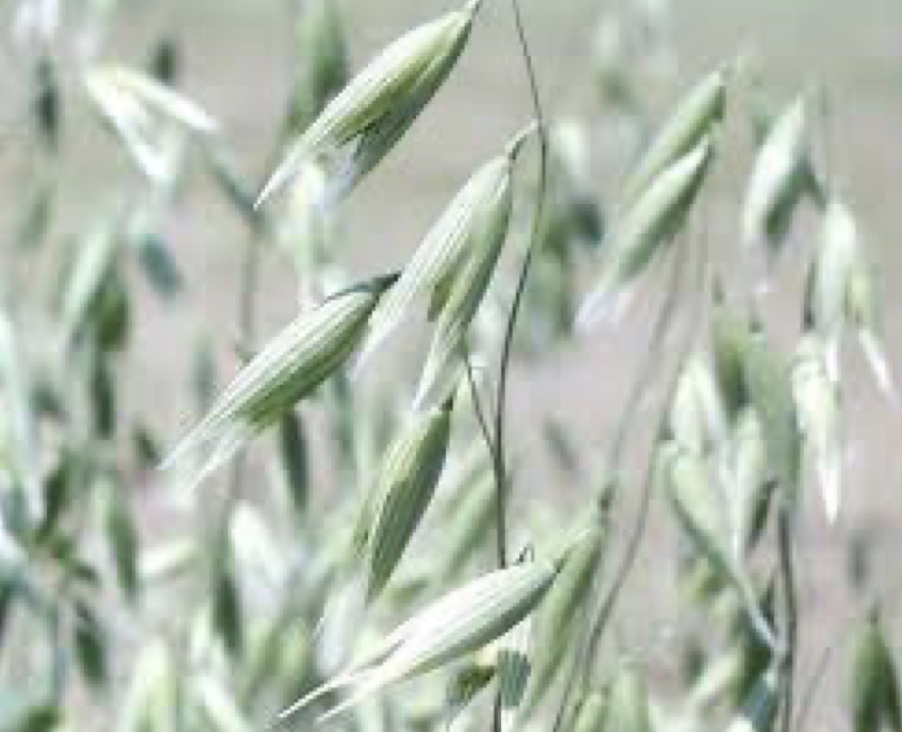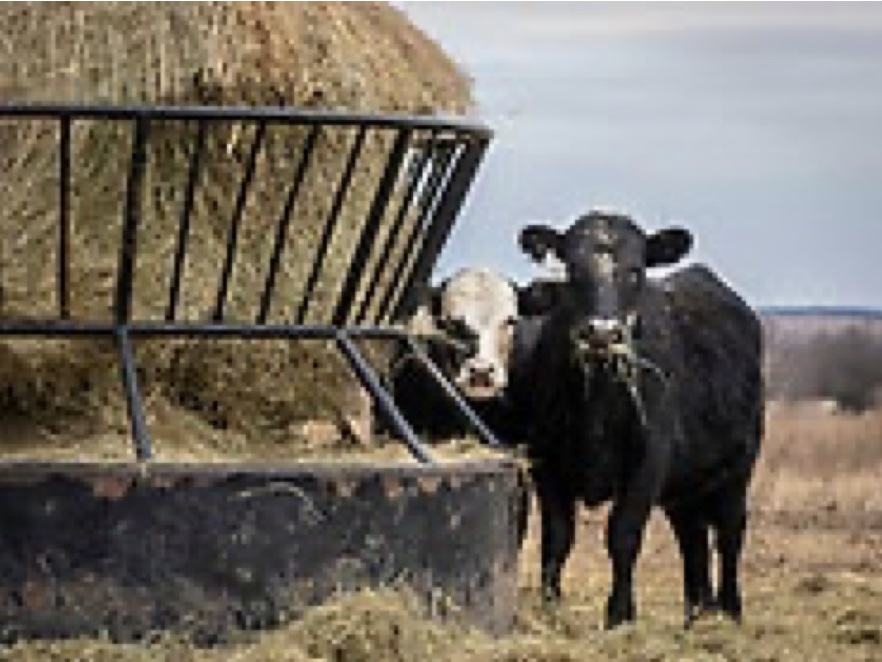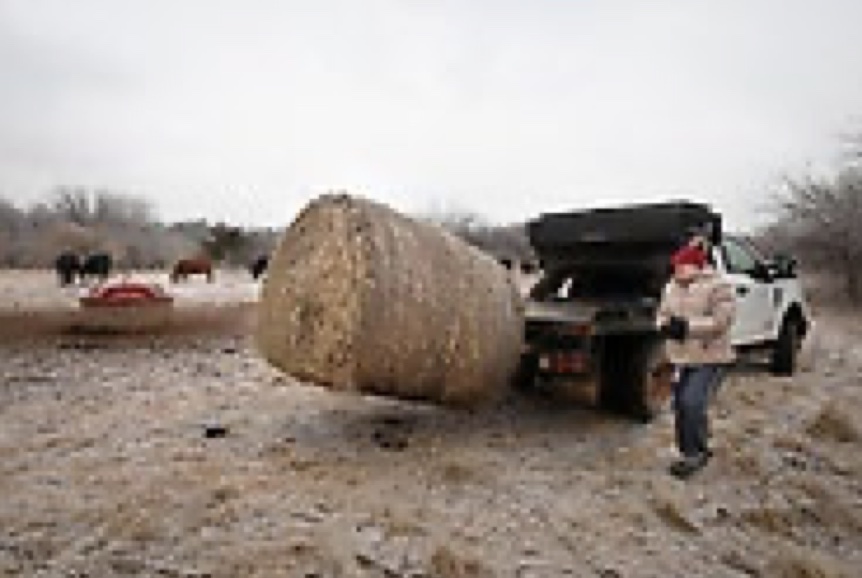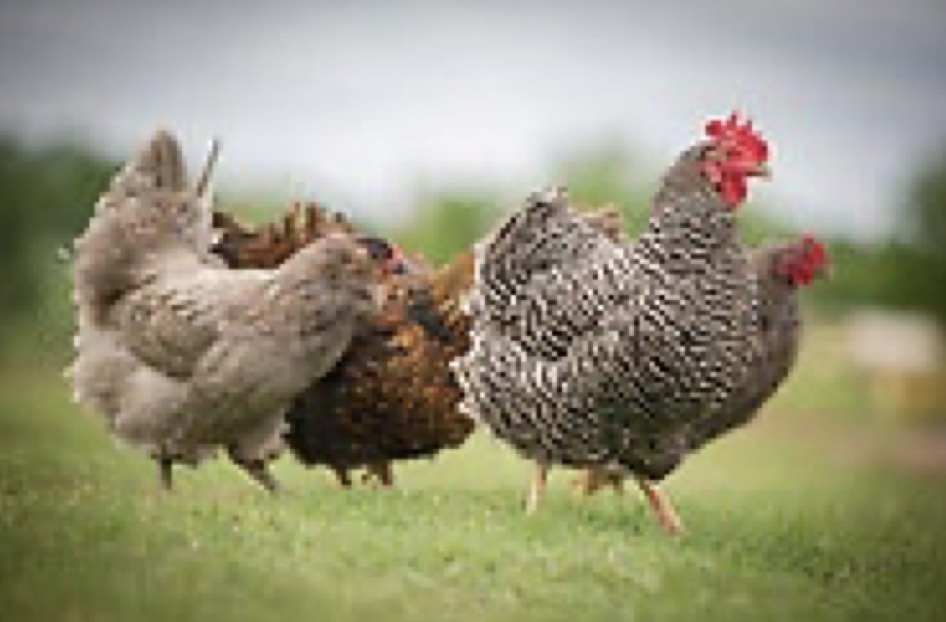Ag Insights November 2023
Wednesday, November 1, 2023
Spring Planted Oats
Josh Bushong, West Area Extension Crops Specialist
 Open fields this winter are prime candidates for a spring forage crop. Spring-planted
oats can provide many possibilities for farmers. Typically, in Oklahoma, oats are
mainly grown for hay, but they can also provide a quick grazing pasture that can bridge
the gap until summer pasture is available or even provide cover for a summer crop.
While oats can be grazed, the crop can’t handle intensive grazing as well as some
of the dual-purpose varieties of wheat.
Open fields this winter are prime candidates for a spring forage crop. Spring-planted
oats can provide many possibilities for farmers. Typically, in Oklahoma, oats are
mainly grown for hay, but they can also provide a quick grazing pasture that can bridge
the gap until summer pasture is available or even provide cover for a summer crop.
While oats can be grazed, the crop can’t handle intensive grazing as well as some
of the dual-purpose varieties of wheat.
Typically, planting dates for Oklahoma are mid-February to mid-March. A minimum average daily soil temperature of 45 degrees is needed to avoid germination issues but waiting until 50 degrees is reached would be more ideal. Sowing oats will be very similar to other small grains like wheat, but oats are much lighter, about 32 lb./bu. Seeding rates range from 80 to 120 lb./A depending on planting conditions and seed costs. Conventionally tilled fields often will have better stand establishment and early seedling vigor, but direct seeding into no-till can still be adequate when previous crop residues are minimum.
Higher seeding rates are often beneficial to achieving forage production goals. Producers should note seed quality and adjust seeding rates accordingly. Ideally, germination rates should be higher than 85%. Spring planted oats usually will not tiller much, so adequate seeding rates can be critical to production from single-stemmed plants.
When selecting oat varieties, one characteristic to inquire about should be maturity. Short maturity oat varieties produce more grain. Medium and longer maturity oat varieties tend to yield more forage. Field research from Texas A&M Agrilife Extension confirmed these statements. Longer maturities were also preferred when used for one- time hay harvest.
Spring-planted winter oats will likely yield less forage than fall-sown winter wheat. Grazing forage production potential from spring-planted oats will average 1,500 to 2,000 pounds of forage per acre. Actual rates of nitrogen would be about 40 to 60 pounds to produce this amount of forage. Since oat seedlings are not as stress tolerant as wheat, it is recommended to wait until the crop is 6 to 8 inched tall before initiating grazing. About 35 to 60 days of grazing should be expected.
When laying down for hay, peak forage quality is reached once the crop reaches the boot growth stage. Harvesting between late boot and head emergence will optimize both tonnage and quality. Delaying harvest past head emergence may lead to more tonnage at the expense of quality, but windrows will dry down sooner. One field trial near Lubbock, TX looked at six hay timings from early boot to firm dough. At early boot the hay had 18.4% crude protein, at fully headed it was 13.9%, and at firm dough it was 8.7%. But the tonnage doubled from early boot to firm dough.
Field research from KSU conducted near Hutchinson, KS showed an average hay forage yield of 4 tons per acre amongst the 20 different varieties studied. These hay yields were obtained with 75 pounds of nitrogen applied preplant and an additional 50 pounds applied approximately six weeks after emergence.
If used for cover, seeding rates can be slightly reduced if the goal is to simply protect the soil from blowing. If the goal of the cover is to prevent soil water evaporation or even to shade out weeds, then seeding rates should not be reduced. If a summer crop is desired, producers need to terminate the oats once stems have elongated but before head development. The crop will start to use more water once it reaches the reproductive growth stages.
There are some broadleaf herbicide options for spring-planted oats. These include some Group 4 (Phenoxy/Auxin) products such as 2,4-D, dicamba, and MCPA, as well as some Group 2 (ALS) products such as Glean, Harmony (SG and Xtra), and Peak. Other broadleaf options include some pre-mixed products such as Bromoxynil 2 + 2,4- D, Wildcard Xtra, Carnivore, Orion, Sentrallas, Supremacy, and Trump Card. Unfortunately, there are not many herbicide options for grass control. Callisto is labeled for crabgrass control if it’s less than three inches. Callisto may result in temporary crop injury.
Producers wanting to learn more about spring-planted oats should contact their local OSU Extension office. More information can also be found in the OSU factsheet PSS- 2160 “Spring-planted Oat for Grazing or Hay Production”.
Reference to commercial products or trade names is made with the understanding that no discrimination is intended and no endorsement by the Oklahoma Cooperative Extension Service is implied.
Is She Old Enough?
Dana Zook, West Area Extension Livestock Specialist
During the past year, heifer retention has been the hot topic due to weather conditions and the shrinking US beef herd. Although the number of heifers sent to the feedyard is up in a recent inventory report, local producers are still retaining some heifers to develop for their own use. Because of this, beef producers who have saved replacement heifers might be interested to hear about research reevaluating heifer development guidelines.
What is the best time to breed a replacement heifer? Traditionally, guidelines have suggested heifers be 60-65% of mature body weight by breeding time. However, in the past 20 years, researchers have had success breeding heifers earlier and at lighter weights (50-59% of mature body weight).
As you would expect, breeding heifers at 55% of their mature weight incurs less input costs. Waiting to breed heifers at 65% of mature weight will obviously incur more costs but more of these heifers will be expected to become pregnant solely due to heavier weight at the start of breeding.

A great deal of research has been done to compare the performance of heifers at developed to various weights. One such study at the University of Nebraska (Funston and Deutscher, 2004) found that developing heifers to 53% versus 58% of mature bodyweight (based on 1200-pound cows) reduced development costs by $22/head. In this study, heifers cycling at breeding time was 74% and 85% in the lighter group and heavier weight groups, respectively. Pregnancy rates were very good overall; 92% for the
lightweight and 88% heavy weight group.
Why would a producer take the risk of breeding heifers earlier and then finding that some of them didn’t get bred? It is a proven fact that when trying to breed heifers earlier, there is a chance that a larger percentage of them won’t get pregnant. For producers who are considering breeding heifers earlier but have concerns about reduced pregnancy rate, I would suggest retaining more heifers than needed. Also, those that have knowledge of their mature cow weight, and the current weight of the heifers can do some quick math to see if the heifers are a candidate for early breeding. For example, a producer with 1200-pound mature cows may have traditionally started breeding heifers after they reached approximately 720 pounds (60% of mature BW). That same producer desiring to target heifers for breeding at 55% of mature weight would breed heifers at around 660 pounds.
The heifer development discussion lends itself to a much broader topic about cow efficiency.
By decreasing the age at which a heifer is bred and has her first calf, the future
cow is more likely to produce more calves in her lifetime. Research has shown
that early bred heifers will get pregnant earlier as cows, which increases the pounds
of calf she weans in her lifetime. Earlier born calves are naturally heavier at weaning
which means more pounds for market or the next stage of production.
Why are we now able to breed heifers earlier? Increased research has allowed the development of new ideas, but our cow herd has also definitely changed over the last several decades. Research suggests the establishment and increased use of EPD’s have contributed to changes in reproductive performance. Also, the genetic trend for increased mature cow body weight in many breeds has impacted the age at puberty.
A great deal of research has been done on heifer development and there really is no right or wrong method. Producers should be realistic and apply the method that best matches their financial circumstances, production methods, and available resources. Nutrition will account for a large portion of heifer development cost despite which method is selected. Seek out nutritional assistance from your county extension educator, area specialist, or nutrition consultant to ensure moderating nutritional costs associated with development.
What Hay Feeder Do You Use?
Dana Zook, West Area Extension Livestock Specialist
 As producers prepare for winter weather and take stock in their hay supplies, it is
important to consider hay feeding management. It’s a reality that hay feeding reduces
the efficiency of beef cow entities. In fact, Dr. Darrell Peel has noted that feeding
hay costs 2.5-5 times more than grazing. It would be easy to say that all cows should
graze pastures and no hay should be fed. However, round bales offer convenience and
can help maintain nutrition and/or improve animal welfare. Some examples of these
situations are inclement weather (think snow, rain, or ice), drought, calving time,
or preconditioning.
As producers prepare for winter weather and take stock in their hay supplies, it is
important to consider hay feeding management. It’s a reality that hay feeding reduces
the efficiency of beef cow entities. In fact, Dr. Darrell Peel has noted that feeding
hay costs 2.5-5 times more than grazing. It would be easy to say that all cows should
graze pastures and no hay should be fed. However, round bales offer convenience and
can help maintain nutrition and/or improve animal welfare. Some examples of these
situations are inclement weather (think snow, rain, or ice), drought, calving time,
or preconditioning.
How do you feed hay? Many producers roll out hay, but others utilize hay feeders. Today we are going to look at the efficiency of hay feeders. Dr. Dave Lalman and his research group have participated in several studies dealing with hay waste. Let’s look at the results of a few studies that evaluate hay feeder design and its effects on waste.
In 2015, researchers used 48 dry cows to test hay waste in one of three hay feeder types; an open ring feeder without a bottom, a sheeted bottom feeder with tapered sides, and a feeder with sheeting on the top and bottom with a hanging chain cone in the center. In this study, cows wasted 19.2% of the bale when using the open ring feeder without a bottom, 13.6% of hay when using the sheeted bottom feeder with tapered sides, and only 8.9% of the hay when the feeder had sheeting on the top and bottom along with a chain cone in the center.
In 2021, 56 cows were used in a hay feeding study evaluating 4 feeders. Feeders included 1.) a steel, open bottom ring feeder, 2.) a poly open bottom ring feeder, 3.) a steel, sheeted bottom feeder, and 4.) a steel, sheeted bottom feeder with a basket feature. Unsurprisingly, most hay was wasted using the steel and poly open bottom feeders (20.4%), followed by the steel sheeted bottom feeder (12.4%). The sheeted bottom ring with the basket was the most efficient hay feeder in this study with only 5.5% of hay wasted.
 As you can see, feeder design does make a difference in these two studies and other
literature supports these findings. Sheeting and the cone/basket features do in fact
help reduce waste. However, based on one-on- one producer input from this research,
more of these features added to the feeder increase the feeder weight. This can be
a problem for producers who have limited labor or don’t have a tractor to move the
feeders. Also, most feeders with the cone feature require a tractor for bale placement.
As you can see, feeder design does make a difference in these two studies and other
literature supports these findings. Sheeting and the cone/basket features do in fact
help reduce waste. However, based on one-on- one producer input from this research,
more of these features added to the feeder increase the feeder weight. This can be
a problem for producers who have limited labor or don’t have a tractor to move the
feeders. Also, most feeders with the cone feature require a tractor for bale placement.
As we consider feed costs in the coming season, let’s consider ways to provide nutrition more efficiently for our cows. This could be long term considerations to stocking rate and land management, but it also could be quick fixes like using a different hay feeder. Every single producer has a different set of circumstances that will control how they can adapt and make effective change. How can you adapt and become a little more efficient feeding cows this season?
For more information on this topic, contact your local county OSU extension educator.
Avian Influenza Update
Barry Whitworth, DVM
Area Food/Animal Quality and Health
Specialist for Eastern Oklahoma
High Path Avian Influenza (HPAI) continues to be a problem in commercial and backyard poultry in the Unites States (US) with over 60 million birds affected. Since the start of the outbreak in 2022, 879 flocks (347 commercial and 532 backyard flocks) have been confirmed with HPAI in the US. Many wild birds and mammals have been affected as well. Five backyard flocks and one commercial flock have been confirmed with HPAI during this outbreak in Oklahoma. The latest was detected in a backyard flock in Carter County on October 16, 2023. For a complete listing of domestic birds, wild birds, and mammals affected by HPAI visit 2022-2023 Detection of High Path Avian Influenza website.
 Avian influenza (AI) is a highly contagious viral disease. The virus is classified
as either Low Path Avian Influenza (LPAI) or HPAI depending on the virulence. This
virus infects many food producing birds such as chickens and turkeys while it commonly
resides in migratory waterfowl and many other wild birds. Most often ducks, geese,
and wild birds harbor the virus in the intestinal tract without having any clinical
signs of the disease. The virus is shed in the feces and respiratory secretions from
infected birds. Poultry can be infected with the virus when they come in direct contact
with infected birds or consume feed that is contaminated with the virus. The virus
can be spread indirectly through objects like shoes, clothes, or equipment contaminated
with the virus.
Avian influenza (AI) is a highly contagious viral disease. The virus is classified
as either Low Path Avian Influenza (LPAI) or HPAI depending on the virulence. This
virus infects many food producing birds such as chickens and turkeys while it commonly
resides in migratory waterfowl and many other wild birds. Most often ducks, geese,
and wild birds harbor the virus in the intestinal tract without having any clinical
signs of the disease. The virus is shed in the feces and respiratory secretions from
infected birds. Poultry can be infected with the virus when they come in direct contact
with infected birds or consume feed that is contaminated with the virus. The virus
can be spread indirectly through objects like shoes, clothes, or equipment contaminated
with the virus.
Clinical signs of the disease vary depending on the severity of the virus and the organ system affected. LPAI usually results in no clinical signs or only mild problems. However, HPAI has many different clinical signs. Death with no symptoms is a common finding. Respiratory problems such as coughing, sneezing, watery eyes, and nasal discharges may be seen. Depression resulting in loss of appetite and decrease consumption of water may occur. Egg production may be impacted with a decrease in production and/or softshell or misshapen eggs. A bird’s comb, wattle, head, eyelids, and hocks may swell. Combs and wattles may turn purple. Nervous system disorders including tremors, incoordination, and unusual positions of the head may be seen. Diarrhea has been reported in some cases. For more information about clinical signs visit Defend the Flock-Signs of Illness.
For commercial and backyard poultry flocks, the best defense against HPAI is a sound biosecurity program. Biosecurity is the development and implementation of management procedures intended to reduce or prevent unwanted threats from entering a flock. The protocol is designed to reduce or prevent the spread of unwanted threats through the flock and eliminate any unwanted pathogens that may enter the flock. Lastly, a biosecurity plan is designed to prevent threats from infecting neighboring poultry operations. Biosecurity can be broken down into four basic areas which include traffic, isolation, sanitation, and husbandry.
The first line of defense should be limiting the traffic that enters the area. Poultry operations should have a perimeter buffer area (PBA). For backyard poultry operations, this could be a fence. In commercial operations this may be a fence or road that surrounds the facility. All entry points need to be clearly marked with “Do Not Enter” signs. In a study by United States Department of Agriculture (USDA) evaluating factors associated with introduction of HPAI in layer farms in the US, the presence of a gate was found to be protective against the introduction of the virus. Gates with signage may encourage people to follow biosecurity protocols.
Inside the PBA, a line of separation (LOS) needs to be established. The LOS isolates the birds from possible sources of infections. The LOS is usually the walls of the poultry building plus the entry point. No person should cross this line without following proper biosecurity protocols. Producers should provide visitors with clean coveralls and disposable shoe covers. Visitors should wash their hands before and after visiting the facility. All visitors should dip their shoes in a disinfectant solution when entering and exiting the facility. Also, no other animals, wild or domestic, should cross the LOS.
Sanitation is one of the most important parts of a biosecurity plan. All equipment, feeders, waterers, and buildings need to be cleaned and disinfected regularly. First, all fecal material and dirt should be physically removed. Next, disinfectants must be applied and allowed sufficient contact time to work properly. Foot baths need to be properly maintained. The property outside the poultry house should be kept mowed and cleaned. Failure to keep the grass cut and/or to promptly clean up feed spills is associated with HPAI.
Poultry producers must also practice good animal husbandry. Flocks need to be observed several times per day. Producers need to collect and dispose of dead birds frequently. Producers should know the clinical signs of a sick bird. Any unusual increases in sick or dead birds should be reported to proper authorities. Backyard producers have several options. They can contact their veterinarian or Oklahoma State University County Extension office. They can also contact the Oklahoma State Veterinarian at 405-522-6141.
The National Poultry Improvement Plan (NPIP) has guidelines for a biosecurity protocol. Commercial and backyard poultry producers should examine the NPIP 14 standards of the biosecurity protocol. Any areas that do not meet the standards need to be addressed. For more information visit The NPIP biosecurity audit form.
Additional sources for backyard poultry producers can be found at the USDA Defend the Flock website.
Protect Your Poultry From Avian Influenza or Oklahoma State University fact sheet Small Flock Biosecurity for Prevention of Avian Influenza ANSI-8301.
Avian Influenza is a major threat to the US and Oklahoma poultry industry. It is the responsibility of all commercial and backyard poultry producers to do everything in their power to protect this industry.
Reference
Swayne, D.E. and Halvorson, D.A. 2003 Influenza. In Y. M. Saif (ed.). Diseases of Poultry, 11th ed. Iowa State Press: Ames, Iowa, 135-160.
Green, A. L., Branan, M., Fields, V. L., Patyk, K., Kolar, S. K., Beam, A., Marshall,
K.,
McGuigan, R., Vuolo, M., Freifeld, A., Torchetti, M. K., Lantz, K., & Delgado, A.
H.
(2023). Investigation of risk factors for introduction of highly pathogenic avian
influenza
H5N1 virus onto table egg farms in the United States,
2022: a case-control study. Frontiers in veterinary science, 10, 1229008.
Extension Experience – Insights into Oklahoma Agriculture
The Northwest Area Extension Staff would like to announce the creation of our new podcast Extension Experience. The Extension Experience podcast is brought to you by Josh Bushong, Trent Milacek, and Dana Zook. Each week they provide perspective on Agriculture topics and offer insight from our experience working with Extension Educators and Producers across Oklahoma.
The Extension Experience podcast is available on Spotify, Google Podcasts, and Apple Podcast platforms. You can also access the episodes on spotlight.
